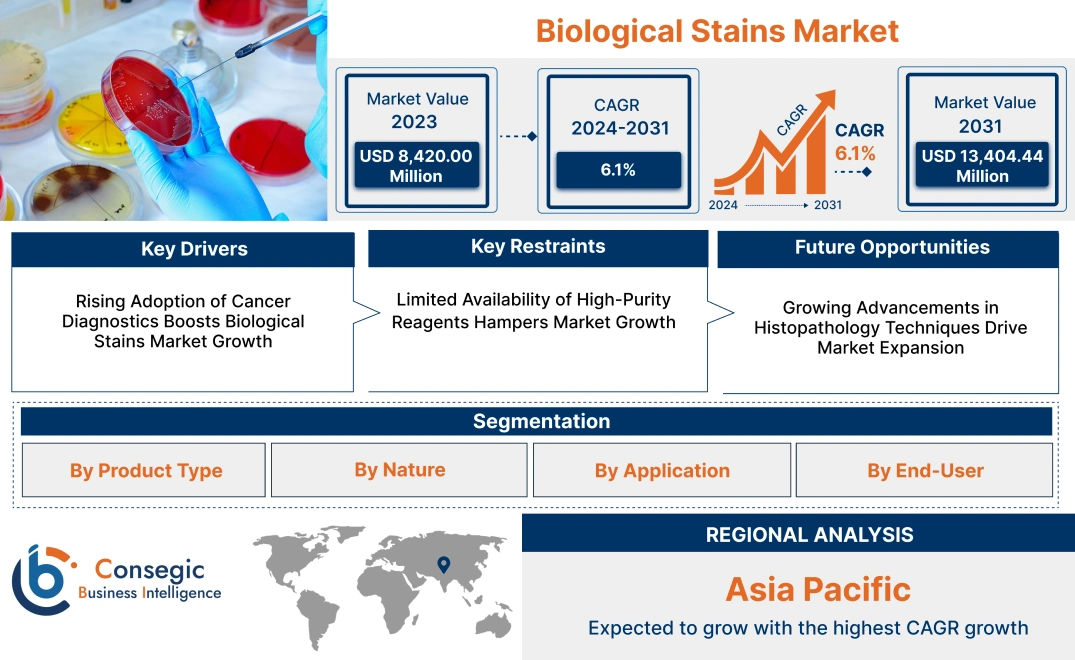- Summary
- Table Of Content
- Methodology
Biological Stains Market Size:
Biological Stains Market size is estimated to reach over USD 13,404.44 Million by 2031 from a value of USD 8,420.00 Million in 2023, growing at a CAGR of 6.1% from 2024 to 2031.
Biological Stains Market Scope & Overview:
The biological stains market focuses on the production and application of stains used to highlight and identify cellular and tissue components in research and clinical diagnostics. It includes dyes like hematoxylin, eosin, and methylene blue, which are essential for visualizing structures under a microscope. These stains are used to differentiate cells, identify microorganisms, and detect abnormalities in tissue samples. Key characteristics include their high specificity, strong staining capabilities, and compatibility with a variety of staining techniques such as Gram staining, acid-fast staining, and immunohistochemistry. The benefits include improved accuracy in diagnostics, enhanced visualization of cellular structures, and support for advanced research in histology and pathology. Applications span clinical laboratories, academic research, and pharmaceutical development. The primary end-users are hospitals, diagnostic centers, research institutions, and pharmaceutical companies, driven by increasing trends for accurate diagnostics and advancements in biomedical research.
Biological Stains Market Dynamics - (DRO) :
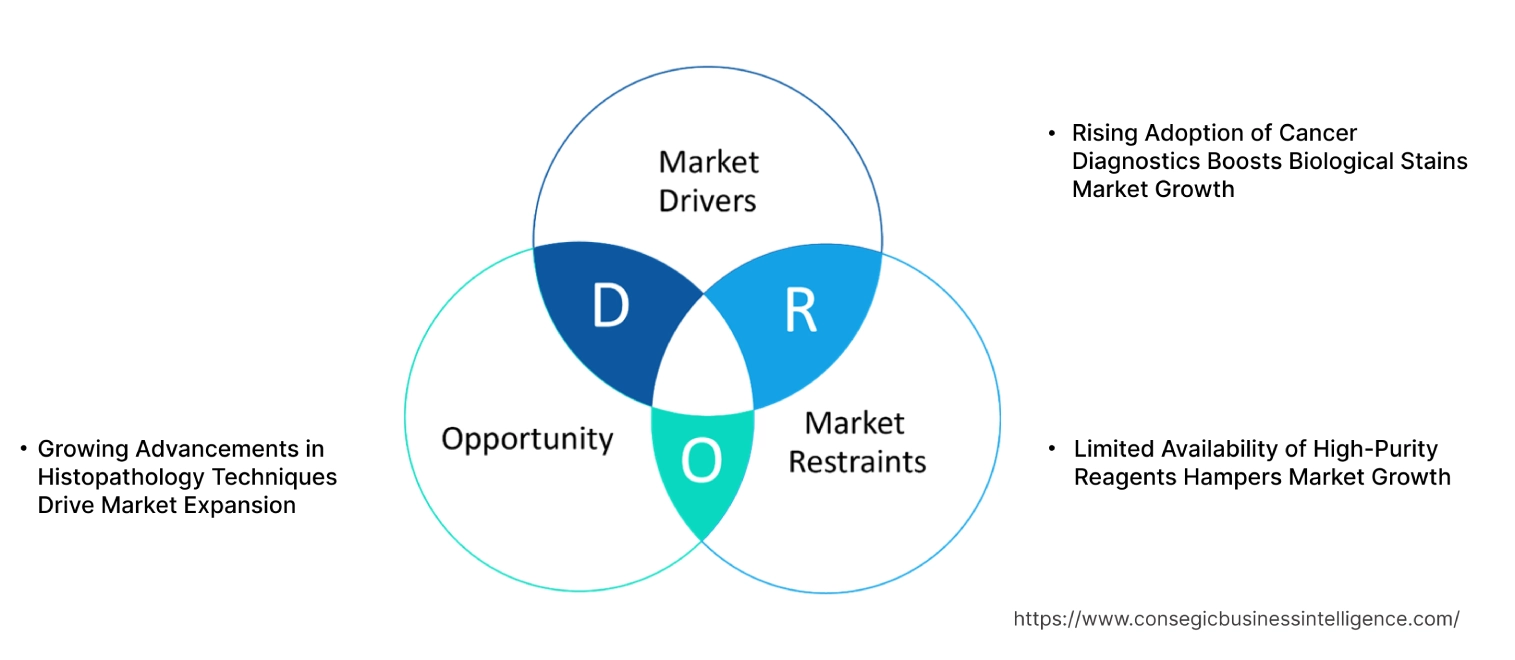
Key Drivers:
Rising Adoption of Cancer Diagnostics Boosts Biological Stains Market Growth
The increasing use of this technology in cancer diagnostics is a significant driver for the market. Stains like Hematoxylin & Eosin (H&E), Giemsa, and Papanicolaou are essential in detecting cancerous cells in tissue samples. The rising incidence of cancers such as breast, lung, and colorectal cancer is leading to a higher volume of biopsies and cytology tests, necessitating reliable staining procedures for accurate histopathological analysis. It enhances the visualization of cellular structures, aiding pathologists in identifying abnormalities. The growing trends focus on early cancer detection and precision oncology is driving the adoption of advanced staining techniques, further supporting biological stains market growth.
Key Restraints :
Limited Availability of High-Purity Reagents Hampers Market Growth
The market faces challenges due to the limited availability of high-purity reagents required for accurate staining. High-quality reagents are essential for consistent and reliable results in clinical and research laboratories. However, the production of pure chemical compounds used in stains like Crystal Violet, Safranin, and Eosin requires stringent quality control and complex synthesis processes. The inconsistent supply of these high-purity reagents can lead to variability in staining outcomes, affecting diagnostic accuracy. This issue is particularly prevalent in developing regions, where access to quality reagents is limited, hindering the broader adoption of biological stains.
Future Opportunities :
Growing Advancements in Histopathology Techniques Drive Market Expansion.
Technological advancements in histopathology and molecular biology present a significant opportunity for the market. New staining techniques, such as immunohistochemistry (IHC) and fluorescent in-situ hybridization (FISH), are gaining popularity due to their enhanced sensitivity and specificity in detecting cellular components and genetic markers. The integration of advanced staining methods with digital pathology systems enables automated, high-precision analysis, reducing manual errors and improving diagnostic accuracy. As the advancement for more sophisticated diagnostic solutions increases, market players have the scope to develop innovative tailored for advanced research and clinical applications, driving future market development.
Biological Stains Market Segmental Analysis :
By Product Type:
Based on product type, the market is segmented into acid fuchsin, Congo red, crystal violet, eosin, and others.
The crystal violet segment accounted for the largest revenue biological stains market share in 2023.
- Crystal violet is a widely used biological stain, primarily known for its application in Gram staining, a critical procedure in microbiology for bacterial differentiation.
- The stain is favored for its ability to penetrate the cell walls of Gram-positive bacteria, providing clear and precise differentiation between Gram-positive and Gram-negative species.
- Its extensive use in clinical laboratories and research institutes, particularly in microbiology and bacteriology, contributes to the segment's dominance.
- The increasing prevalence of bacterial infections and the rising appeals for accurate microbial identification further support the strong market position of crystal violet.
- Crystal violet dominates the market due to its essential role in Gram staining, which is a cornerstone procedure in microbiology for bacterial identification.
The eosin segment is anticipated to register the fastest CAGR during the forecast period.
- Eosin is extensively used in histology and cytology for tissue staining, particularly in hematoxylin and eosin (H&E) staining procedures.
- This acidic dye is highly effective in staining cell cytoplasm, collagen, and red blood cells, providing distinct contrast for microscopic examination of tissues.
- The growing trends for eosin in diagnostic pathology, driven by increasing cancer diagnostics and histopathological studies, are contributing to its rapid development.
- Additionally, advancements in tissue staining techniques and the rising number of biopsies are expected to boost the market for eosin.
- Eosin is expected to grow rapidly, driven by its critical role in tissue staining and the rising advancement of diagnostic pathology in cancer detection.
By Nature:
Based on nature, the market is segmented into acidic stains, basic stains, and neutral stains.
The basic stains segment accounted for the largest revenue share in 2023.
- Basic stains are widely utilized in biological staining due to their strong affinity for nucleic acids and acidic cell components.
- These stains, such as crystal violet and methylene blue, are integral in staining procedures for visualizing cellular structures, particularly in microbiology and cytology.
- The ability of basic stains to bind effectively with negatively charged cellular components makes them indispensable in differentiating cell morphology and identifying pathogens.
- The increasing use of basic stains in clinical and diagnostic applications supports their leading position in the market.
- Basic stains dominate the market due to their strong affinity for nucleic acids and widespread use in cellular visualization across various diagnostic and research applications.
The Oncology in the application is expected to grow at the fastest CAGR over the forecast period.
- Acidic stains, such as eosin and acid fuchsin, are primarily used for staining cytoplasmic structures and extracellular matrix components.
- These stains are essential in histological applications, particularly in procedures like hematoxylin and eosin staining, which is a standard method in pathology for tissue examination.
- The rising focus on cancer diagnostics and tissue-based research, along with advancements in staining techniques, is driving the applications for acidic stains.
- The segment trends are further supported by the increasing adoption of advanced staining protocols in pathology laboratories.
- Thus, acidic stains are expected to grow rapidly, driven by their crucial role in histological staining and the increasing applications for precise tissue diagnostics in pathology.
By Application:
Based on application, the market is segmented into histology & cytology, microbiology, bacteriology, DNA staining, protein staining, Gram staining, and others.
The histology & cytology segment accounted for the largest revenue share in 2023.
- Histology and cytology are core applications of biological stains, involving the examination of tissues and cells for diagnostic purposes.
- Stains like eosin, hematoxylin, and crystal violet are commonly used in these procedures to enhance contrast and highlight specific cellular structures.
- The increasing use of cancer diagnostics and tissue analysis, coupled with the rising number of biopsy procedures, is driving the trends in this segment.
- The trends of precision medicine and personalized healthcare further emphasize the importance of histological staining in patient diagnostics.
- Therefore, histology & cytology lead the market due to the critical role of biological stains in tissue examination and the rising applications for diagnostic accuracy in cancer and other pathological conditions.
The DNA staining segment is anticipated to register the fastest CAGR during the forecast period.
- DNA staining is a specialized application, used for visualizing nucleic acids in various molecular and genetic studies.
- Stains like DAPI and ethidium bromide are extensively used in DNA gel electrophoresis, flow cytometry, and fluorescence microscopy.
- The increasing focus on genetic research, advancements in molecular diagnostics, and the growing use of DNA staining in forensic science are driving the rapid growth of this segment.
- The rising biological stains market trends for DNA analysis in clinical and research settings are further propelling this segment's advancement.
- Therefore, as the biological stains market analysis shows, DNA staining is expected to grow rapidly, driven by the increasing focus on genetic research and the rising use of molecular diagnostics in clinical and forensic applications.
By End-User:
Based on end-users, the market is segmented into clinical laboratories, research institutes, pharmaceutical & biotechnology companies, academic institutes, and diagnostic centers.
The clinical laboratories segment accounted for the largest revenue share of 32.05% biological stain market share in 2023.
- Clinical laboratories are the primary users of this market, particularly for diagnostic purposes in microbiology, histology, and cytology.
- The use of stains like Gram stain and hematoxylin-eosin is critical for identifying pathogens and analyzing tissue samples.
- The increasing number of diagnostic tests, coupled with the growing prevalence of infectious diseases and cancer, drives the appeal in clinical laboratories.
- Additionally, the development of diagnostic services and advancements in staining protocols enhance the efficiency of laboratory testing.
- Thus, clinical laboratories dominate the market, driven by their extensive use of biological stains in diagnostic procedures and the increasing demand for reliable, accurate testing in disease identification.
The clinical laboratories segment accounted for the largest revenue share of 32.05% biological stain market share in 2023.
- Pharmaceutical and biotechnology companies utilize biological stains extensively in drug development, quality control, and research studies.
- Stains are critical in cellular assays, protein analysis, and the evaluation of tissue samples during preclinical trials.
- The growing focus on drug discovery, the development of biopharmaceuticals, and the need for precise cell and tissue study are driving the market demand in this segment.
- The adoption of advanced staining techniques and automated systems in pharmaceutical R&D is further supporting the rapid growth of this segment.
- Pharmaceutical & biotechnology companies are expected to grow rapidly, driven by their increasing use of biological stains in drug discovery, quality control, and advanced research studies.
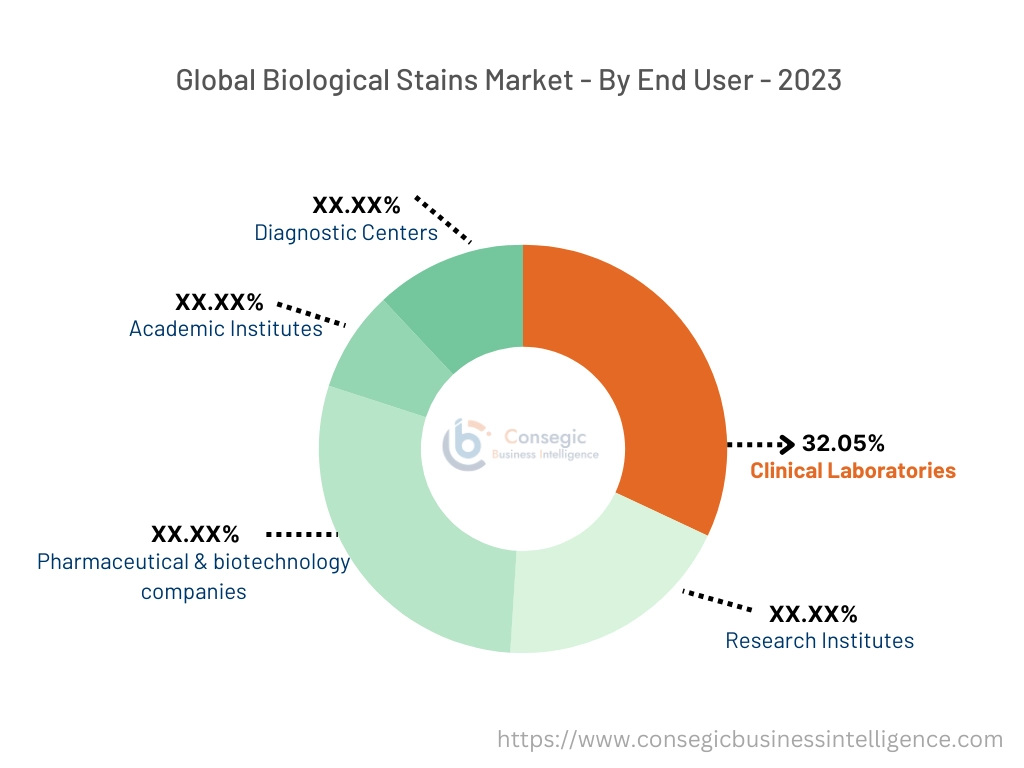
Regional Analysis:
The regions covered are North America, Europe, Asia Pacific, the Middle East and Africa, and Latin America.
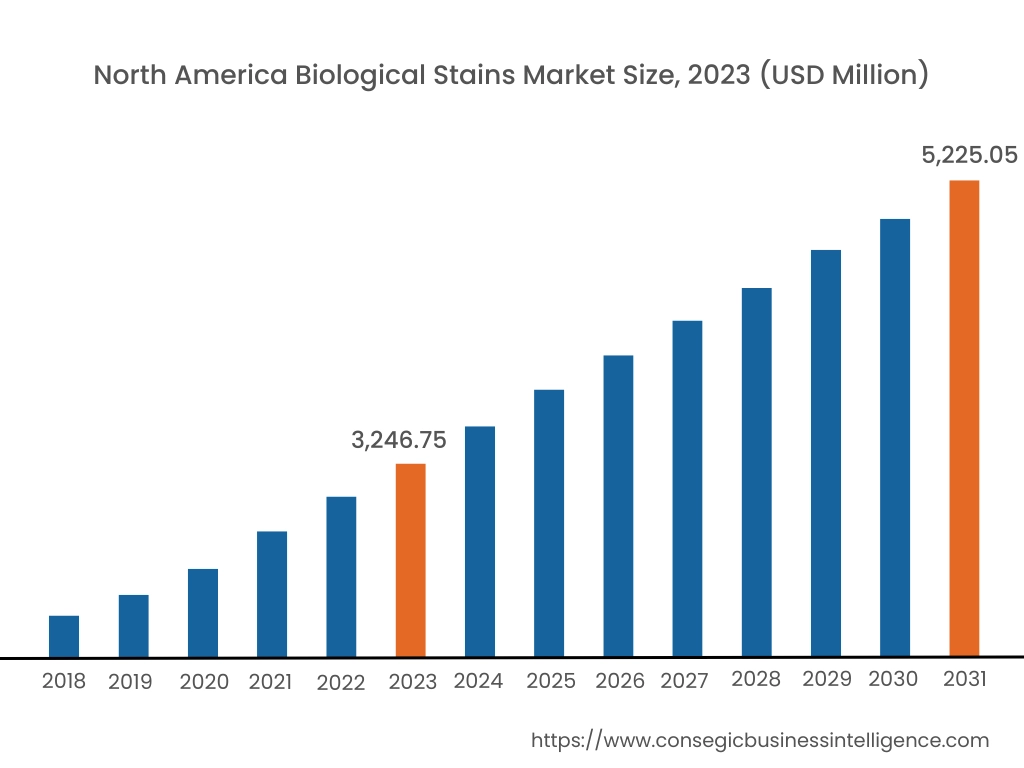
In 2023, North America accounted for the highest market share at 38.56% and was valued at USD 3,246.75 Million and is expected to reach USD 5,225.05 Million in 2031. In North America, the U.S. accounted for the highest share of 65.21% during the base year of 2023. North America leads the market, primarily driven by extensive research activities and a well-established healthcare infrastructure. The U.S. dominates the region, with strong demand from academic research laboratories, clinical diagnostics, and pharmaceutical companies engaged in drug discovery. The growing focus on cancer diagnostics and histopathological studies has led to increased utilization of biological stains like hematoxylin and eosin. Canada is also witnessing rising biological stains market opportunities, particularly in microbiological research and veterinary diagnostics, supported by investments in life sciences and biotechnology.
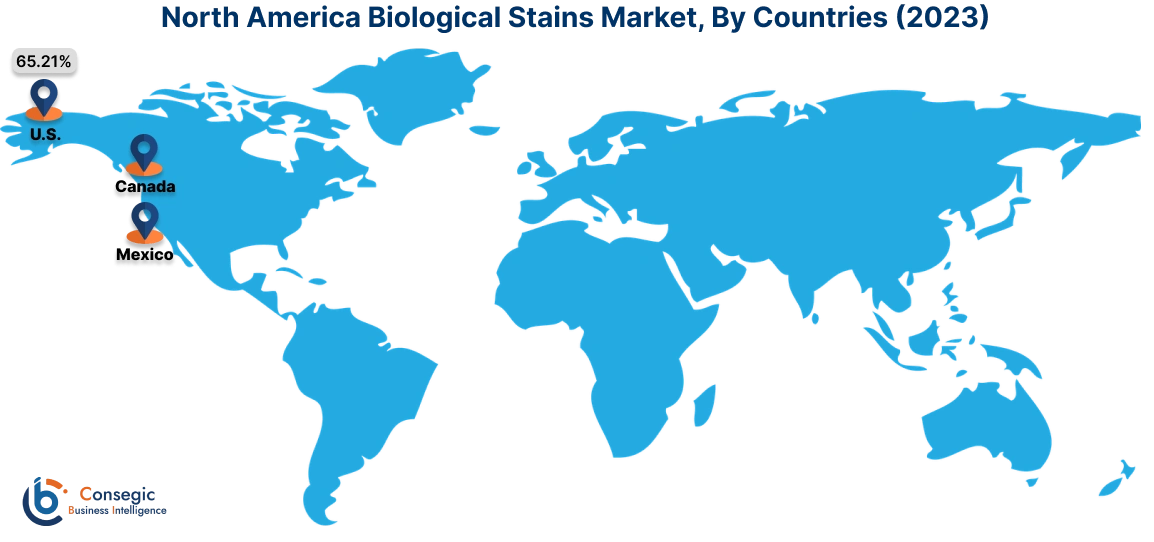
In Asia Pacific, the market is experiencing the fastest growth with a CAGR of 6.8% over the forecast period. Asia-Pacific market is fueled by increasing research activities and rising healthcare expenditures in countries like China, Japan, and India. China's focus on expanding its pharmaceutical and biotechnology sectors is driving the biological stains market opportunities in drug discovery and clinical research. Japan's advanced medical research infrastructure and focus on early cancer detection techniques are key factors propelling market growth. In India, the rapid rise of pathology labs and diagnostic centers, coupled with growing awareness of early disease detection, is boosting the adoption resulting in biological stains market expansion for histological and microbiological applications.
Europe is a significant rise in biological stains market trends, with robust advancement, from clinical pathology and biomedical research sectors. The UK, Germany, and France are at the forefront, driven by their advanced healthcare systems and strong focus on cancer research. Germany's well-established pharmaceutical industry and emphasis on innovative drug testing protocols contribute to the widespread use of staining techniques in histology and cytology. The European market is also influenced by regulatory requirements for accurate diagnostics, boosting demand for high-quality and certified biological stains. However, strict regulations on chemical usage and environmental concerns may impact the availability of certain staining reagents.
The Middle East & Africa region is experiencing steady growth in the biological stains market analysis, driven by increasing investments in healthcare infrastructure and the expansion of diagnostic laboratories. The UAE and Saudi Arabia are key markets, focusing on enhancing clinical diagnostics and supporting advanced research in life sciences. South Africa's growing focus on infectious disease research, particularly in tuberculosis and HIV, is boosting demand for microbiological stains. However, the region faces challenges related to limited local production capabilities and dependency on imports, which can affect the availability and cost of high-quality.
In Latin America, Brazil and Mexico lead the market, supported by expanding healthcare services and rising investments in life sciences research. Brazil's pathology and cytology sectors are driving biological stains market demand used in cancer diagnostics and tissue analysis. Mexico's growing pharmaceutical industry and the increasing number of research institutes are contributing to the demand for biological stains in molecular biology and microbiology. Despite the growth potential, the market faces challenges from limited access to advanced staining technologies and variability in the quality of locally produced stains, which may hinder widespread adoption.
Top Key Players & Market Share Insights:
The biological stains market is highly competitive with major players providing products and services to the national and international markets. Key players are adopting several strategies in research and development (R&D), product innovation, and end-user launches to hold a strong position in the global biological stains market. Key players in the biological stains industry include -
- Merck KGaA (Germany)
- Thermo Fisher Scientific Inc. (USA)
- Abcam plc (UK)
- Agilent Technologies, Inc. (USA)
- Sigma-Aldrich Corporation (USA)
- Beckman Coulter, Inc. (USA)
- Santa Cruz Biotechnology, Inc. (USA)
- Cell Signaling Technology, Inc. (USA)
- Vector Laboratories (USA)
- Avantor, Inc. (USA)
Biological Stains Market Report Insights :
| Report Attributes | Report Details |
| Study Timeline | 2018-2031 |
| Market Size in 2031 | USD 13,404.44 Million |
| CAGR (2024-2031) | 6.1% |
| By Product Type |
|
| By Nature |
|
| By Application |
|
| By End-User |
|
| By Region |
|
| Key Players |
|
| North America | U.S. Canada Mexico |
| Europe | U.K. Germany France Spain Italy Russia Benelux Rest of Europe |
| APAC | China South Korea Japan India Australia ASEAN Rest of Asia-Pacific |
| Middle East and Africa | GCC Turkey South Africa Rest of MEA |
| LATAM | Brazil Argentina Chile Rest of LATAM |
| Report Coverage |
|
Key Questions Answered in the Report
What is the market size of the biological stains industry? +
Biological Stains Market size is estimated to reach over USD 13,404.44 Million by 2031 from a value of USD 8,420.00 Million in 2023, growing at a CAGR of 6.1% from 2024 to 2031.
What drives the biological stains market? +
Key drivers include increasing demand for diagnostics, rising research activities in life sciences, and advancements in staining technologies.
Which regions dominate the biological stains market? +
North America and Europe lead the market, followed by Asia-Pacific due to expanding research infrastructure and diagnostics demand.
What are the primary applications of biological stains? +
They are used in microscopy, histology, cytology, and molecular biology for cell and tissue analysis.
What are the key challenges in the biological stains market? +
Challenges include stringent regulations, high costs of advanced stains, and limited awareness in developing regions.
